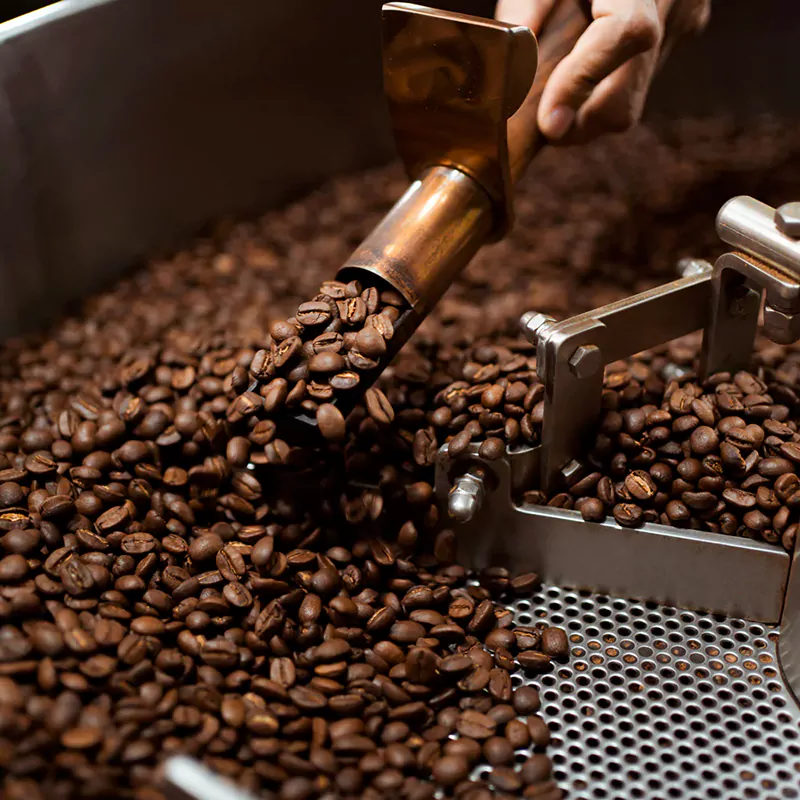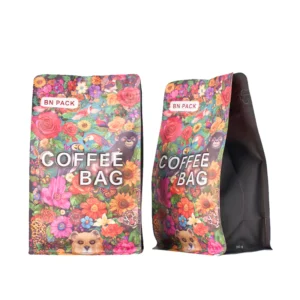The Maillard reaction, named after French chemist Louis Camille Maillard, is a complex series of chemical interactions between amino acids (proteins) and reducing sugars that occurs under heat. This reaction is responsible for the browning of roasted coffee beans. During coffee roasting, the Maillard reaction begins around 140–150°C (284–302°F) and intensifies as temperatures rise, producing hundreds of aromatic and flavor compounds, such as pyrazines, furans, and melanoidins. These compounds define coffee’s signature roasted, nutty, chocolatey, and caramelized notes.
The reaction’s progression depends on time, temperature, and moisture levels in the beans. For example, higher temperatures accelerate the reaction, while residual moisture in green beans can slow its onset. Melanoidins, the brown polymers formed during this phase, not only give coffee its color but also enhance mouthfeel and stabilize espresso crema.
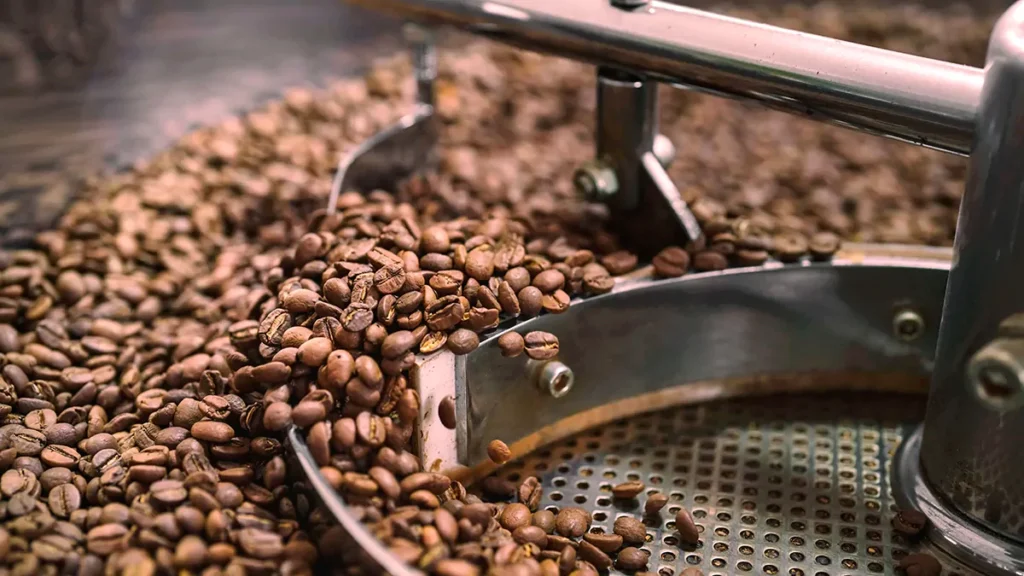
What Are the Different Phases of Coffee Roasting?
“Coffee roasting, to me, is a lot like conducting a symphony,” says James Bellis, founder of Balance Coffee, during our interview. “Each phase builds on the last, and together they transform raw, green beans into this beautiful harmony of aroma and flavor. While there’s a lot of technicality involved, at its core, roasting is really about intuition and precision working hand in hand.”
The Drying Phase: Setting the Stage for Transformation
Imagine green coffee beans as sponges, brimming with moisture from their tropical origins. As they tumble into the roaster, heat begins its quiet work. The beans shed their grassy hue, turning a soft golden yellow as steam whispers out. This phase isn’t merely about drying; it’s a delicate dance of energy transfer. Roasters must balance airflow and heat to avoid scorching dense, high-altitude beans like Ethiopian heirlooms, which demand patience to preserve their future floral highs.
Yet here lies a paradox: rush this stage, and the beans’ inner moisture lingers like an uninvited guest, muddying later reactions. Specialty roasters often stretch drying times for nuanced varieties. Take a Costa Rican Tarrazú—by gently coaxing out moisture over six minutes, its crisp apple-like acidity remains poised to shine in lighter roasts. It’s a reminder that even in simplicity, restraint breeds complexity.
The Browning Phase
Now the roaster’s chamber hums with possibility. As temperatures climb past 180°C (356°F), the Maillard reaction awakens—a clandestine meeting of amino acids and sugars. This isn’t mere browning; it’s the birth of flavor alchemy. Pyrazines weave earthy undertones, while furans spin caramel ribbons through the beans. Nearby, caramelization works its sweeter magic, breaking down stubborn sugars into maltol’s toasted-marshmallow whispers. The air thickens with the scent of baking bread and melted chocolate—a perfumed prelude to first crack.
But timing is a tightrope walk. Push too hard, and the beans “bake,” their vibrant acidity collapsing into flat monotony. Savvy roasters might dial back heat by 10%, extending this golden window. Picture a Brazilian Santos batch: three minutes here coaxes out hazelnut richness while preserving a flicker of citrus—proof that mastery lies in listening to the beans’ crackling song.
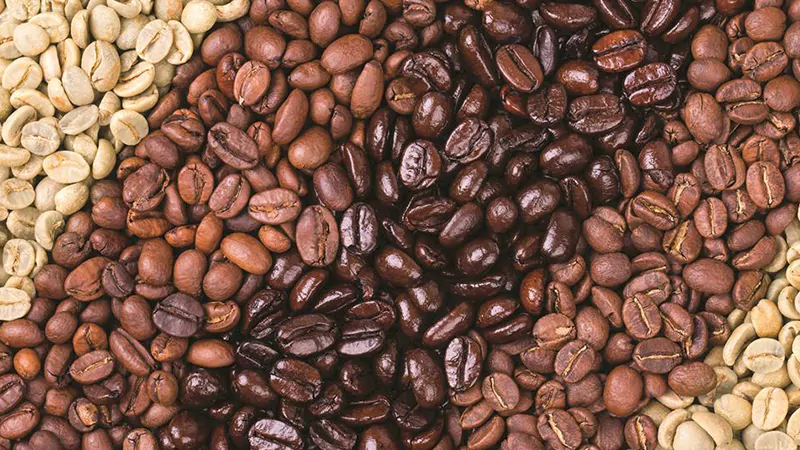
The Development Phase
After the first crack signals the transition, roasters enter a critical decision-making window. The Rate of Rise (RoR)—a measure of how quickly bean temperature increases—is meticulously monitored to prevent overheating. By gradually reducing heat input, professionals ensure temperatures decline at a controlled rate (e.g., from 10°C per minute to 5°C), avoiding scorching while allowing complex flavor development. Techniques like water quenching, where a fine mist is sprayed into the roaster, enable abrupt termination of the roast for light profiles, preserving delicate acids like malic or citric acid in beans such as Kenyan AA.
Post-roast challenges emerge immediately. Darker roasts, with extended development times, produce substantial CO₂ emissions for days. This necessitates packaging engineered to manage degassing without compromising freshness.
How Does the Maillard Reaction Affect the Flavour of Coffee?
The Maillard reaction isn’t just a chemical process—it’s the architect of coffee’s soul. As BESCA ROASTERS’ lead roaster emphasizes, “This reaction dictates whether a coffee whispers its origin story or shouts its roast character.” Here’s how its precise control shapes every sip:

Flavor Complexity: From Subtlety to Intensity
When amino acids and reducing sugars intertwine under heat, they birth a spectrum of flavors. Shorter Maillard phases (common in light roasts) preserve volatile compounds like fruity ethyl acetate or floral linalool, allowing Ethiopian Yirgacheffe to showcase jasmine and bergamot notes. Extend the reaction, however, and deeper molecules dominate: pyrazines build dark chocolate foundations, while furanones layer toasted hazelnut richness—a hallmark of Sumatra Mandheling dark roasts.
The key lies in timing. For example, BESCA’s Nordic-style roasts intentionally truncate Maillard development at 150 seconds to highlight Kenyan coffee’s redcurrant acidity, whereas their Italian espresso blend extends it to 210 seconds, amplifying cocoa bittersweetness.
Mouthfeel: The Invisible Texture Maker
Melanoidins, the brown polymers formed during prolonged Maillard reactions, act as coffee’s “liquid velvet.” These macromolecules bind to oils, increasing viscosity for that coveted syrupy body in espresso. A 2022 SCA study found that melanoidin-rich dark roasts scored 23% higher in mouthfeel evaluations compared to light roasts.
Balance: Walking the Flavor Tightrope
“Rush the Maillard, and you’ll curse the acidity; overdo it, and bitterness haunts the cup,” warns BESCA’s roaster. Light roasts risk underdevelopment, leaving harsh chlorogenic acids unchecked (think sour green apple). Conversely, excessive reactions convert delicate quinides into aggressive phenols, muddying flavors with ashy undertones.
The solution? Precision roasting paired with smart packaging. For instance, medium-roast Colombian beans achieve harmony when Maillard-driven caramel sweetness (from fructose breakdown) offsets citric acidity. BN PACK’s moisture-controlled biodegradable bags lock in this equilibrium—their starch-based liners regulate humidity to prevent flavor shifts during transit.
Do Different Roast Profiles Require Different Packaging?
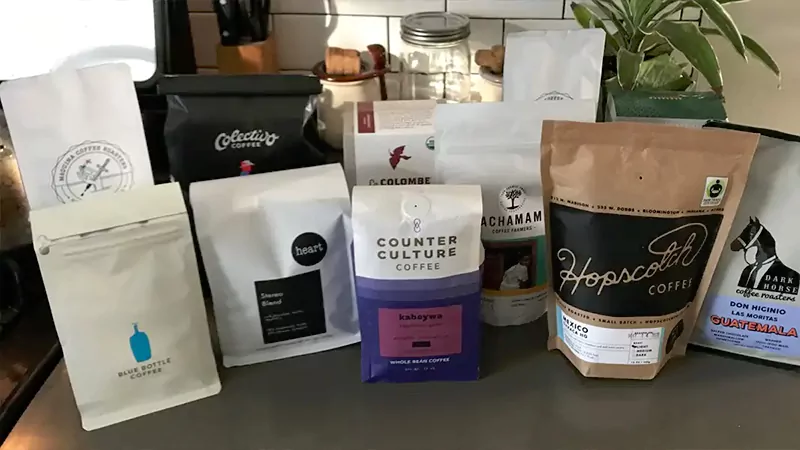
Absolutely. Roast profiles influence coffee’s degassing behavior, shelf life, and flavor preservation, necessitating tailored packaging solutions. Here’s how BN PACK’s sustainable packaging addresses these needs:
Degassing Management:
Dark roasts, with extended Maillard phases, produce more CO₂. BN PACK’s bags feature BPA-free, recyclable degassing valves that release gas without oxygen ingress, preventing bloating and preserving freshness.
Aroma Protection:
Volatile compounds from the Maillard reaction degrade quickly. Our multi-layer barrier films (e.g., aluminum or biodegradable PLA liners) block oxygen, light, and moisture, locking in delicate aromas.
Custom Design for Flavor Cues:
Light roasts with bright acidity pair well with green, angular packaging to subliminally signal freshness, while medium/dark roasts benefit from warm, rounded designs (e.g., browns, reds) to evoke richness.
Sustainability Alignment:
BN PACK’s compostable and recyclable bags cater to eco-conscious roasters. For example, our plant-based PBAT films decompose in industrial facilities, aligning with the coffee industry’s push toward circularity.
Related Products
Conclusion
Mastering the Maillard reaction is key to unlocking coffee’s flavor potential, but preserving these qualities demands intelligent packaging. BN PACK combines science-driven design with eco-friendly materials to protect your roast’s integrity—from light, acidic profiles to bold, caramelized dark blends. Explore our range of customizable, sustainable coffee bags to elevate your brand and deliver freshness in every cup.
Visit BN PACK’s product catalog to discover packaging solutions tailored to your roast profile.
